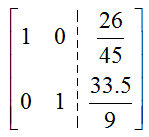
In December of 2014, Sony released the movie The Interview online after threats to theaters cancelled the debut in theaters. As originally reported in Wall Street Journal, the sales figures reported in January contained an interesting math problem appropriate for algebra students.
The following January, Sony reported sales of 31 million dollars from the sales and rentals of The Interview. They sold the movies online for 15 dollars and rented through various sites for 6 dollars. If there were 4.3 million transactions, how many of the transaction were sales of the movie and how many of the transactions were rentals?
If you recognize that this problem may be modeled by a system of linear equations, you are dead on. Let’s start by defining two variables to what we are looking for:
S: number of sales transactions for The Interview in millions
R: number of rental transactions for The Interview in millions
These variables also relate to the total sales as well as the total number of transactions. Since there were a total of 4.3 million transactions,
S + R = 4.3
Each sale of the movie yields 15 dollars in sales and each rental results in 6 dollars in sales. Thus the total sales yields
15S + 6R = 31
Putting these equations together gives the system of linear equations,
S + R = 4.3
15S + 6R = 31
The second strategy for solving the problem involves solving the system using matrices..
Strategy 2: Matrix Method
Using an augmented matrix, we can write the system as
Well put this into reduced row echelon form using row operations. The entry in the first row, first column is a 1, so we put a 0 in the second row, first column:
-15R1 + R2 -> R2
Now put a 1 in the second row, second column:
-1/9R2 -> R2
Finally, put a zero in the first row, second column:
-R2 + R1 -> R1
This gives the solution S = 26/45≈0.58 and R = 33.5/9≈3.72. Remember that each variable is in millions so there were approximately 0.58 million sale transactions and 3.72 million rental transactions. Based on the critical reviews of the movies as well as Pineapple Express, the large number of rentals was justified.
Often corporate reports can be examined for similar data that can be used to construct systems of linear equations.




